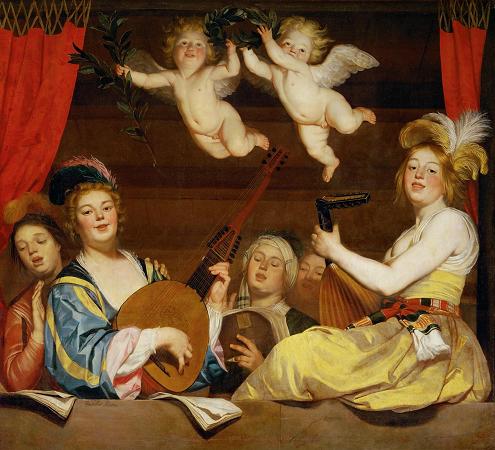Concert. A concert is a live music performance in front of an audience. The performance may be by a single musician, sometimes then called a recital, or by a musical ensemble, such as an orchestra, choir, or band. Concerts are held in a wide variety and size of settings, from private houses and small nightclubs, dedicated concert halls, arenas and parks to large multipurpose buildings, and even sports stadiums. Indoor concerts held in the largest venues are sometimes called arena concerts or amphitheatre concerts. Informal names for a concert include show and gig. Regardless of the venue, musicians usually perform on a stage. Concerts often require live event support with professional audio equipment. Before recorded music, concerts provided the main opportunity to hear musicians play. While the first concerts didn't officially appear until the late 17th century, similar gatherings had been around throughout the 17th century at several European universities, such as Oxford and Cambridge. Officially, though, the first public concerts that required an admission were created by the English violinist, John Banister. Over the next few centuries, concerts began to gain larger audiences, and classical symphonies were very popular. Finally, after World War 2, these events changed into the modern concerts that take place today. An example of an early, post-WW2 concert is the Moondog Coronation Ball. As stated in the general history part above, the first known occurrence of concerts where people are charged admission took place at violinist John Banister's home in Whitefriars, London in 1672. 6 years later in 1678, a man by the name of Thomas Britton held weekly concerts in Clerkenwell. However, these concerts were different. Before, you had an admission that you paid upon entering the building where the concert was held but at Britton's concerts, patrons purchased a yearly subscription to come to the concerts. At 10 shillings a year, people could see as many concerts they wanted to. In addition to holding concerts at certain venues, concerts also went to the people. In 17th century France, concerts were performed in the homes of the nobility, for only the nobility. Organized by Anne Danican Philidor, the first public concerts in France, and arguably the world, were the Concerts Spirituels. These concerts were held on religious holidays when the Opera was closed and served as a model for concert societies all over the world. In the late 18th century, music from the likes of Haydn and Mozart was brought and performed in English concerts. One notable work from Haydn performed at these concerts was his set of 12 symphonies, also referred to as the London Symphonies. Concerts reflecting the elegance of England during the time period were held at the gardens of Vauxhall, Ranelagh, and Marylebone. The musical repertoire performed at these events ranged from works composed by young Mozart, to songs that were popular in that time period. The nature of a concert varies by musical genre, individual performers, and the venue. Concerts by a small jazz combo or small bluegrass band may have the same order of program, mood, and volume, but vary in music and dress. In a similar way, a particular musician, band, or genre of music might attract concert attendees with similar dress, hairstyle, and behavior. For example, concert goers in the 1960s often had long hair, sandals and inexpensive clothing made of natural fibers. Regular attendees to a concert venue might also have a recognizable style that comprises that venue's scene. A recital is a concert by a soloist or small group which follows a program. It can highlight a single performer, sometimes accompanied by piano, or a performance of the works of a single composer, or a single instrument. The invention of the solo piano recital has been attributed to Franz Liszt. Also, a recital may have many participants, as for a dance recital. A dance recital is a presentation of choreographed moves for an audience, usually in an established performing arts venue, possibly competitively. Some dance recitals are seasonal. Some performers or groups put on very elaborate and expensive shows. To create a memorable and exciting atmosphere and increase the spectacle, performers frequently include additional entertainment devices. These can include elaborate stage lighting, electronic imagery via system and/or pre-recorded video, inflatable sets, artwork or other set pieces, various special effects such as theatrical smoke and fog and pyrotechnics, and unusual costumes or wardrobe.
more...














